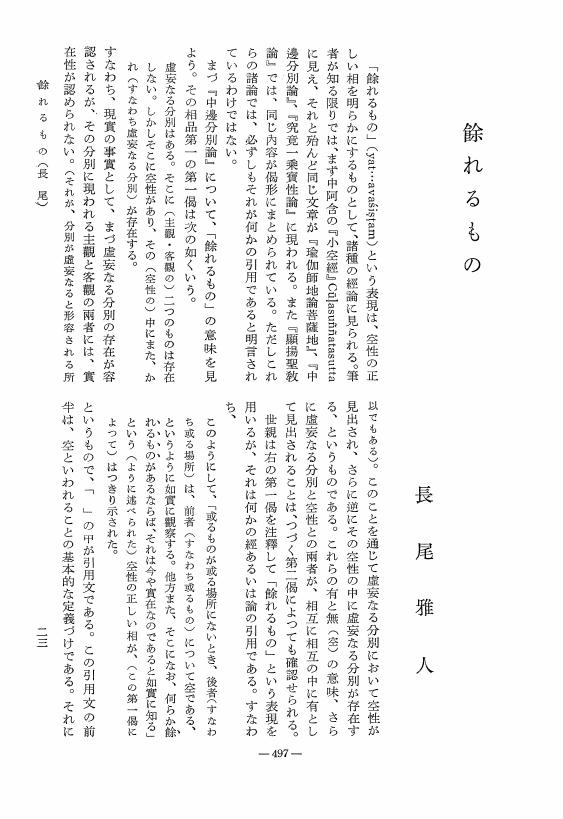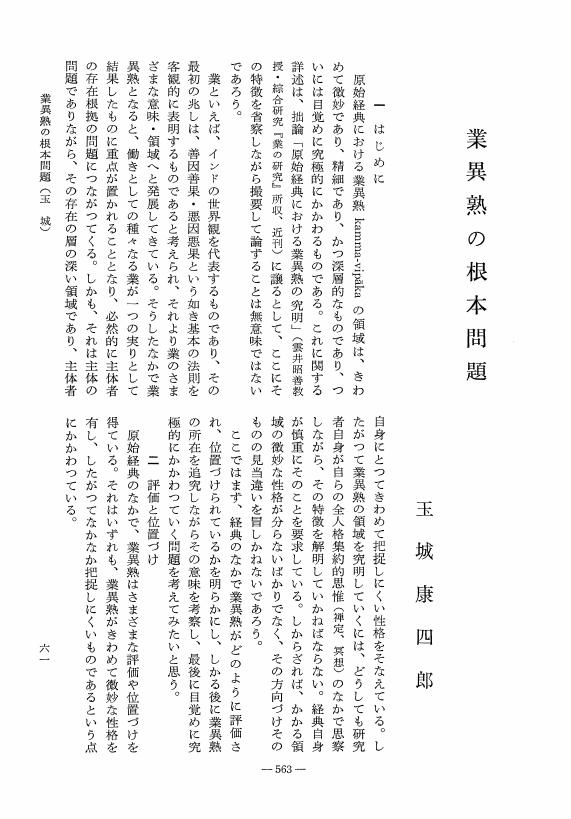1 0 0 0 OA 餘れるもの
- 著者
- 長尾 雅人
- 出版者
- Japanese Association of Indian and Buddhist Studies
- 雑誌
- 印度學佛教學研究 (ISSN:00194344)
- 巻号頁・発行日
- vol.16, no.2, pp.497-501, 1968-03-31 (Released:2010-03-09)
1 0 0 0 OA 異読に基づく写本系統の探究――Dīghanikāyaのコム文字による写本を中心として――
- 著者
- バンチャード チャオワリットルアンリット
- 出版者
- 日本印度学仏教学会
- 雑誌
- 印度學佛教學研究 (ISSN:00194344)
- 巻号頁・発行日
- vol.68, no.3, pp.1155-1159, 2020-03-25 (Released:2020-09-10)
- 参考文献数
- 9
Dhammachai Tipitaka Projectでは,Dīghanikāyaの新校訂版を作成するために,シンハラ文字,ビルマ文字,コム文字,そしてタム文字という4つの写本伝承から,延べ45本の写本が,主要な資料として厳選された.このテキストを編集する過程において,十分な数の異読が収集されていくと,パーリ聖典の写本伝承に関する新しい理解を提案することが可能になりつつある.概して言うと,パーリ聖典は,シンハラと東南アジアという2つの主要な系統を通じて私たちに伝わっているよう思われる.後者は,さらにビルマ文字,コム文字,そしてタム文字の写本系統に分けられる.本論文では,コム文字の写本系統に焦点を当てることによって,少なくともラッタナコーシン期以前とラッタナコーシン期(1782年以降)という2つの分岐系統が存在することが判明した.前者はまれな写本にのみ現存するが,後者は,タイにおけるパーリ聖典の標準版となるSyāmaraṭṭha版の基礎であると考えられる.歴史を振り返れば,アユタヤ王国が1767年に戦争で完全に破壊された時には,パーリ聖典を含む膨大な数のコム文字写本が失われたようである.そのことから,パーリ聖典のコム伝承はシンハラやビルマの伝承からの助けを得ながら,自分の伝承を回復せざるを得なかったという指摘がある.つまり,コム伝承では両伝承からの混交(contamination)という問題があることを意味する.しかし,ダムロン王子の記録及び本論文で取り扱うコム文字写本に見出される異読を検証した結果,アユタヤ期以降のパーリ聖典のコム伝承は,シンハラやビルマ伝承との著しい混交を示していない.逆に,ラッタナコーシン期のコム文字写本のいくつかの読みは,コム伝承が独自のものであり,シンハラとビルマの両伝承から距離を置くことが確認された.
1 0 0 0 OA 業異熟の根本問題
- 著者
- 玉城 康四郎
- 出版者
- Japanese Association of Indian and Buddhist Studies
- 雑誌
- 印度學佛教學研究 (ISSN:00194344)
- 巻号頁・発行日
- vol.27, no.2, pp.563-571, 1979-03-31 (Released:2010-03-09)
1 0 0 0 OA 律蔵の成立問題に関する現在の状況
- 著者
- 佐々木 閑
- 出版者
- Japanese Association of Indian and Buddhist Studies
- 雑誌
- 印度學佛教學研究 (ISSN:00194344)
- 巻号頁・発行日
- vol.54, no.2, pp.938-931,1331, 2006-03-20 (Released:2010-03-09)
At present we do not have a clear understanding of the historical process through which the existing Vinaya materials came into being. One of the most noteworthy points in this field is the difference in structure between Theravada Vinayas and the Mahasamghika Vinaya. It is thought that the compilation process of the Vinaya may be clarified by explaining the reason for this difference. On this point, scholars such as Frauwallner, Hirakawa, Yinshun, Clarke and myself have presented various theories. Clarke's theory, the most recent addition to the discussion, rejects the thesis of Frauwallner's famous work. If Clarke's criticisms are correct, then his interpretation is a revolutionary contribution to the study of the Vinaya. However, there is a serious logical contradiction in Clarke's theory, and therefore Frauwallner's theory cannot be dismissed. In this article, I will outline these past theories and point out the problems in Clarke's work.
1 0 0 0 OA 手足網縵相の意味
- 著者
- 勝本 華蓮
- 出版者
- Japanese Association of Indian and Buddhist Studies
- 雑誌
- 印度學佛教學研究 (ISSN:00194344)
- 巻号頁・発行日
- vol.54, no.1, pp.408-402,1273, 2005-12-20 (Released:2010-07-01)
Jala-hatthapada is one of the thirty-two characteristics of a great man like the Buddha. In Northern Buddhism, it implies that He had membranes/webs between the digits of His hands and feet.However, Buddhaghosa's commentaries refute this idea. Buddhaghosa argues that under the rule of the Vinaya, such a man cannot become even a monk. Moreover, the commentaries explain that the lines formed by the digits and their knots in the great man appear like nets.Some scholars argued this matter and concluded that the idea of webbed digits emanated from a misinterpretation of the sculptures of the Buddha, whose digits were connected by sculptors to prevent them from fracturing.In this paper, I attempt to demonstrate that the idea of webbed digits originates from the Sarvastivada school. The evidence is as follows. The word “hamsa-raja” (the king of ganders) appears as a simile of jalini-panipada (=jala-hatthapada) in a Sanskrit scripture, namely, the Mahavadana-sutra, and in the Chinese versions of other sutras; all of these were disseminated by the same school. Moreover, I found pictures of two sculptures with webbed digits, probably carved between the 2nd and 3rd centuries in Mathura, where the Sarvastivada school was influential.
1 0 0 0 OA ジャイナ教の植物観
- 著者
- 渡辺 研二
- 出版者
- Japanese Association of Indian and Buddhist Studies
- 雑誌
- 印度學佛教學研究 (ISSN:00194344)
- 巻号頁・発行日
- vol.41, no.2, pp.1069-1063, 1993-03-25 (Released:2010-03-09)
1 0 0 0 別本太子成道變文介紹
- 著者
- 平野 顯照
- 出版者
- 日本印度学仏教学会
- 雑誌
- 印度學佛教學研究 (ISSN:00194344)
- 巻号頁・発行日
- vol.16, no.1, pp.354-360, 1967
1 0 0 0 OA 『無門関』第三十五則「倩女離魂」の材源について
- 著者
- 松村 恒
- 出版者
- Japanese Association of Indian and Buddhist Studies
- 雑誌
- 印度學佛教學研究 (ISSN:00194344)
- 巻号頁・発行日
- vol.47, no.2, pp.580-585, 1999-03-20 (Released:2010-03-09)
1 0 0 0 OA 初期唯識思想と独我論 ――安慧と『成唯識論』 ――
- 著者
- 源 重浩
- 出版者
- 日本印度学仏教学会
- 雑誌
- 印度學佛教學研究 (ISSN:00194344)
- 巻号頁・発行日
- vol.58, no.1, pp.444-440, 2009-12-20 (Released:2017-09-01)
- 著者
- 井上 信生
- 出版者
- 日本印度学仏教学会
- 雑誌
- 印度學佛教學研究 (ISSN:00194344)
- 巻号頁・発行日
- vol.58, no.1, pp.302-299, 2009-12-20 (Released:2017-09-01)
- 著者
- 佐藤 隆彦
- 出版者
- 日本印度学仏教学会
- 雑誌
- 印度學佛教學研究 (ISSN:00194344)
- 巻号頁・発行日
- vol.64, no.1, pp.12-18, 2015
1 0 0 0 OA Nyaya-Vaisesika 学派の普遍の定義について
- 著者
- 竹中 智泰
- 出版者
- Japanese Association of Indian and Buddhist Studies
- 雑誌
- 印度學佛教學研究 (ISSN:00194344)
- 巻号頁・発行日
- vol.32, no.1, pp.521-516, 1983-12-25 (Released:2010-03-09)
1 0 0 0 仏教儀礼における音楽の位置 -仏前奏楽の意味-
- 著者
- 天納 傳中
- 出版者
- 日本印度学仏教学会
- 雑誌
- 印度學佛教學研究 (ISSN:00194344)
- 巻号頁・発行日
- vol.33, no.2, pp.452-457, 1985
1 0 0 0 天台教学における地獄の問題
- 著者
- 神達 知純
- 出版者
- 日本印度学仏教学会
- 雑誌
- 印度學佛教學研究 (ISSN:00194344)
- 巻号頁・発行日
- vol.55, no.1, pp.64-67,1188, 2006
In Tiantai doctrine, naraka is known as one of the ten realms of living beings (十界). In China many Buddist scriptures that had a well-organized description about naraka had already been translated and written in the Northern and Southern dynasties. It follows that Zhiyi (智〓) developed ideas such as that each of the ten realms contains the other nine within itself (十界互具), in times when fear of naraka was common. In this report I take up some problems about naraka which are derived from the four-word phrase about Sila and Yana (戒乗四句) in "<i>Mohe Ziguan</i> (摩詞止観)".
1 0 0 0 『法華経開題』にみる空海の一乗思想
- 著者
- 米田 達也
- 出版者
- 日本印度学仏教学会
- 雑誌
- 印度學佛教學研究 (ISSN:00194344)
- 巻号頁・発行日
- vol.59, no.1, pp.78-83, 2010
1 0 0 0 OA アーラヤ識とアーラヤ智
- 著者
- 谷口 富士夫
- 出版者
- 日本印度学仏教学会
- 雑誌
- 印度學佛教學研究 (ISSN:00194344)
- 巻号頁・発行日
- vol.59, no.1, pp.450-446, 2010-12-20 (Released:2017-09-01)
1 0 0 0 新出『妙法蓮華経八香印儀軌』不空訳の発見と内容
- 著者
- 野本 覚成
- 出版者
- 日本印度学仏教学会
- 雑誌
- 印度學佛教學研究 (ISSN:00194344)
- 巻号頁・発行日
- vol.62, no.1, pp.70-75, 2013
1 0 0 0 OA 大乗戒勅許と最澄の最期をめぐる定説への疑義――『叡山大師伝』を中心に――
- 著者
- 張堂 興昭
- 出版者
- 日本印度学仏教学会
- 雑誌
- 印度學佛教學研究 (ISSN:00194344)
- 巻号頁・発行日
- vol.67, no.1, pp.28-33, 2018-12-20 (Released:2019-09-07)
- 参考文献数
- 7
The biography of Saichō, called Eizan Daishiden was written about 1200 years ago. In the biography, it is written that Saichō was repeatedly petitioning the court to allow monks of the Tendai school at Mount Hiei to become ordained as national public priests under the Bodhisattva Precepts, rather than order the traditional ordination system of the prātimokṣa. But his request was rejected, and he passed away on June 4th in 822. After his death, his supporters, usually bureaucrats, including Tomono Kunimichi, petitioned the emperor with Saichō’s earnest wish again. Finally, on June 11th, 7 days after his death, the request for the Bodhisattva Precepts was allowed.This series of stories has been handed down for 1200 years. However, some reliable reports and works of history have shown that on a day before Saichō’s passing, the emperor had already given permission for the Bodhisattva Precepts.I propose that the description about Saichō’s last moment in the Eizan Daishiden is false.
1 0 0 0 Vasubandhu 研究ンート (1)
- 著者
- 松田 和信
- 出版者
- 日本印度学仏教学会
- 雑誌
- 印度學佛教學研究 (ISSN:00194344)
- 巻号頁・発行日
- vol.32, no.2, pp.1042-1039, 1984
1 0 0 0 OA 聖一派の入宋・入元僧について-円爾の東福寺僧団と宋元の禅宗-
- 著者
- 佐藤 秀孝
- 出版者
- Japanese Association of Indian and Buddhist Studies
- 雑誌
- 印度學佛教學研究 (ISSN:00194344)
- 巻号頁・発行日
- vol.53, no.2, pp.592-597, 2005-03-20 (Released:2010-03-09)








